Experimental Investigation of Particulate Number Measurement Methodology for Micro-Turbojet Engine Emissions
Abstract
:1. Introduction
2. Engine and Measurement Instruments
2.1. Engine and Operating Conditions
2.2. nvPM Measurement System
3. Results and Discussion
3.1. Microscopic Characterization of Exhaust Particles from Micro-Turbojet Engines
3.2. Comparison of the PN between a Micro-Turbojet Engine and a Micro-Piston Engine
3.3. Comparison of the PSD, GMD and GSD between a Micro-Turbojet Engine and a Micro-Piston Engine
4. Conclusions
- (1)
- A comparative analysis of the emission particle morphology between micro-turbojet engines and PowerJet SaM146 jet engines revealed significant distinctions. Under 30% thrust conditions, micro-turbojet engines exhibited higher abundances of larger, intricately shaped particulates, while at 70% thrust, the particles displayed agglomeration with smaller individual sizes. These differences were attributed to elevated combustion temperatures, improved combustion efficiency, and changes in combustion kinetics in the micro-turbojet engines. In contrast, the standard large aero engine displayed compact fractal aggregates. The particle size variation was primarily linked to the combustion temperature, emphasizing the need for further investigations into the PN emission characteristics of micro-turbojet engines.
- (2)
- The investigation characterized the PN concentrations from a micro-turbojet engine across various operational conditions using APC and MSS instruments. Applying emission index calculations from ICAO regulations resulted in an EIn range of 2.0–3.3 × 1016/(kg fuel) and an EIm range of 8–40 mg/kg fuel. Notably, both the EIn and EIm displayed a trend of an initial decrease, followed by an increase during part-load thrust periods, resembling the patterns observed in the micro-piston engines. Despite the lower EIn in the piston engines compared with the turbojet engines, the difference in combustion pressures led to a greater degree of carbonization within the piston engine.
- (3)
- The size distributions for the turbojet engine indicated a GMD in the range of 80–130 nm, exceeding the typical 30–100 nm range for turbofan engines. The GSD spanned from 1.37 to 1.44, with both the GMD and GSD exhibiting a trend of initially decreasing and then increasing with increasing engine thrust. Compared with the turbofan jet engines, the piston engines showed higher GMD and GSD values, attributed to factors like a reduced air–fuel ratio, a lower combustion efficiency, and the presence of semi-volatile compounds resulting from incomplete fuel combustion.
Author Contributions
Funding
Data Availability Statement
Conflicts of Interest
References
- Abrantes, I.; Ferreira, A.F.; Silva, A.; Costa, M. Sustainable aviation fuels and imminent technologies-CO2 emissions evolution towards 2050. J. Clean Prod. 2021, 313, 127937–127950. [Google Scholar] [CrossRef]
- Rötger, T.; Eyers, C.; Fusaro, R. A Review of the Current Regulatory Framework for Supersonic Civil Aircraft: Noise and Emissions Regulations. Aerospace 2023, 11, 19. [Google Scholar] [CrossRef]
- Zhou, Y.; Pei, J.; Ding, S.; Zhao, S.; Zhu, K.; Shao, L.; Zhong, Z.; Du, F.; Li, X.; Xu, Z. Theoretical model for high-altitude gas exchange process in multi-fuel poppet valves two-stroke aircraft engine. Energy Convers. Manag. 2024, 301, 118028. [Google Scholar] [CrossRef]
- Saluja, H.S.; Yin, F.; Gangoli Rao, A.; Grewe, V. Effect of Engine Design Parameters on the Climate Impact of Aircraft: A Case Study Based on Short-Medium Range Mission. Aerospace 2023, 10, 1004. [Google Scholar] [CrossRef]
- Verhagen, W.J.; Santos, B.F.; Freeman, F.; van Kessel, P.; Zarouchas, D.; Loutas, T.; Yeun, R.C.; Heiets, I. Condition-Based Maintenance in Aviation: Challenges and Opportunities. Aerospace 2023, 10, 762. [Google Scholar] [CrossRef]
- Zhou, Y.; Song, Y.; Zhao, S.; Li, X.Y.; Shao, L.; Yan, H.; Ding, S.T. A comprehensive aerodynamic-thermal-mechanical design method for fast response turbocharger applied in aviation piston engines. Propul. Power Res. 2024, 13, 145–165. [Google Scholar] [CrossRef]
- Cinieri, G.; Shah, Z.A.; Marseglia, G.; De Giorgi, M.G. Toward Zero Carbon Emissions: Investigating the Combustion Performance of Shaped Microcombustors Using H2/Air and NH3/Air Mixtures. Aerospace 2023, 11, 12. [Google Scholar] [CrossRef]
- Liu, J.; Liu, J. Experimental investigation of the effect of ammonia substitution ratio on an ammonia-diesel dual-fuel engine performance. J. Clean. Prod. 2024, 434, 140274. [Google Scholar] [CrossRef]
- Xu, Z.; Wang, M.; Chang, L.; Pan, K.; Shen, X.; Zhong, S.; Xu, J.; Liu, L.; Li, G.; Chen, L. Assessing the particulate matter emission reduction characteristics of small turbofan engine fueled with 100% HEFA sustainable aviation fuel. Sci. Total Environ. 2024, 945, 174128. [Google Scholar] [CrossRef]
- Lee, B.H.; Santoni, G.W.; Wood, E.C.; Herndon, S.C.; Miake-Lye, R.C.; Zahniser, M.S.; Munger, J.W. Measurements of nitrous acid in commercial aircraft exhaust at the alternative aviation fuel experiment. Environ. Sci. Technol. 2011, 45, 7648–7654. [Google Scholar] [CrossRef]
- Ershov, M.A.; Klimov, N.A.; Savelenko, V.D.; Makhova, U.A.; Burov, N.O.; Karpunin-Ozherovskiy, E.V.; Aleksanyan, D.R.; Donskaya, E.S.; Mukhina, D.Y.; Kapustin, V.M.; et al. An Overview of the Global Market, Fleet, and Components in the Field of Aviation Gasoline. Aerospace 2023, 10, 863. [Google Scholar] [CrossRef]
- Chen, P.C.; Lan, Y.B.; Huang, X.Y.; Qi, H.X.; Wang, Q.B.; Wang, J.; Wang, L.L.; Xiao, H.X. Droplet deposition and control of planthoppers of different nozzles in two-stage rice with a quadrotor unmanned aerial vehicle. Agron. J. 2020, 10, 303–316. [Google Scholar] [CrossRef]
- Owen, B.; Anet, J.G.; Bertier, N.; Christie, S.; Cremaschi, M.; Dellaert, S.; Terrenoire, E. Particulate matter emissions from aircraft. Atmosphere 2022, 13, 1230. [Google Scholar] [CrossRef]
- Jasiński, R. Analysis of particle emissions from a jet engine including conditions of afterburner use. Energies 2022, 15, 7696. [Google Scholar] [CrossRef]
- Cohen, Y.; Hauglustaine, D.; Bellouin, N.; Eastham, S.; Tronstadt Lund, M.; Matthes, S.; Skowron, A.; Thor, R. Impact of aircraft NOx and aerosol emissions on atmospheric composition: A model intercomparison. In Proceedings of the EGU General Assembly Conference Abstracts, Vienna, Austria & Online, 23–28 April 2023. [Google Scholar]
- Ahrens, D.; Méry, Y.; Guénard, A.; Miake-Lye, R.C. A new approach to estimate particulate matter emissions from ground certification data: The nvPM mission emissions estimation methodology. J. Eng. Gas Turbines Power 2023, 145, 031019. [Google Scholar] [CrossRef]
- Corbin, J.C.; Schripp, T.; Anderson, B.E.; Smallwood, G.J.; LeClercq, P.; Crosbie, E.C.; Achterberg, S.; Whitefield, P.D.; Miake-Lye, R.C.; Yu, Z.; et al. Aircraft-engine particulate matter emissions from conventional and sustainable aviation fuel combustion: Comparison of measurement techniques for mass, number, and size. Atmos. Meas. Tech. 2022, 15, 3223–3242. [Google Scholar] [CrossRef]
- Crayford, A.; Johnson, M. SAMPLE III SC.01-\Studying, sAmpling and Measuring of Aircraft Particulate Emission; European Aviation Safety Agency: Cologne, Germany, 2011. [Google Scholar]
- Marsh, R.; Crayford, A.; Petzold, A. SAMPLE II-Studying, sAmpling and Measuring of Particulate Matter II; European Aviation Safety Agency: Cologne, Germany, 2009. [Google Scholar]
- ARP Procedure for the Continuous Sampling and Measurement of Non-Volatile Particulate Matter Emissions from Aircraft Turbine Engines; SAE Int.: Warrendale, PA, USA, 2020.
- Gao, J.; Ma, C.; Tian, G.; Chen, J.; Xing, S.; Huang, L. Oxidation activity restoration of diesel particulate matter by aging in air. Energ. Fuel 2018, 32, 2450–2457. [Google Scholar] [CrossRef]
- Gren, L.; Malmborg, V.B.; Falk, J.; Markula, L.; Novakovic, M.; Shamun, S.; Pagels, J. Effects of renewable fuel and exhaust aftertreatment on primary and secondary emissions from a modern heavy-duty diesel engine. J. Aerosol Sci. 2021, 156, 105781–105797. [Google Scholar] [CrossRef]
- Moore, R.H.; Thornhill, K.L.; Weinzierl, B.; Sauer, D.; D’Ascoli, E.; Kim, J.; Lichtenstern, M.; Scheibe, M.; Beaton, B.; Beyersdorf, A.J.; et al. Biofuel blending reduces particle emissions from aircraft engines at cruise conditions. Nature 2017, 543, 411–415. [Google Scholar] [CrossRef]
- Liu, J.H.; Liu, Z.G.; Wang, L.J.; Wang, P.; Sun, P.; Ma, H.J.; Wu, P.C. Effects of PODE/diesel blends on particulate matter emission and particle oxidation characteristics of a common-rail diesel engine. Fuel Process. Technol. 2021, 212, 106634–106643. [Google Scholar] [CrossRef]
- Eigentler, F.; Gerlinger, P.M.; Eggels, R. Soot CFD simulation of a real aero engine combustor. In Proceedings of the AIAA Scitech 2022 Forum, San Diego, CA, USA, 3–7 January 2022; p. 0489. [Google Scholar]
- Zhang, C.; Wang, R.X.; Hui, X.; Xue, X.; Lin, Y.Z.; Sung, C.J. Nonlinear Threshold Sooting Index Prediction Method for Surrogate Formulation Emulating Sooting Characteristics: A Case Study Using RP-3 Jet Fuels. Energ. Fuel 2020, 34, 9990–9999. [Google Scholar] [CrossRef]
- Narciso, M.; deSousa, J.M.M. Influence of Sustainable Aviation Fuels on the Formation of Contrails and Their Properties. Energies 2021, 14, 5557. [Google Scholar] [CrossRef]
- Dick, W.D.; Ziemann, P.J.; McMurry, P.H. Multiangle Light-Scattering Measurements of Refractive Index of Submicron Atmospheric Particles. Aerosol Sci. Technol. 2007, 41, 549–569. [Google Scholar] [CrossRef]
- Przysowa, R.; Gawron, B.; Białecki, T.; Łęgowik, A.; Merkisz, J.; Jasiński, R. Performance and Emissions of a Microturbine and Turbofan Powered by Alternative Fuels. Aerospace 2021, 8, 25–45. [Google Scholar] [CrossRef]
- Zhang, C.Q.; Chen, L.F.; Ding, S.T.; Zhou, X.F.; Chen, R.; Zhang, X.L.; Yu, Z.H.; Wang, J. Mitigation effects of alternative aviation fuels on non-volatile particulate matter emissions from aircraft gas turbine engines: A review. Sci. Total Environ. 2022, 820, 153233–153250. [Google Scholar] [CrossRef] [PubMed]
- Liberacki, A.; Trincone, B.; Duca, G.; Aldieri, L.; Vinci, C.P.; Carlucci, F. The Environmental Life Cycle Costs (ELCC) of Urban Air Mobility (UAM) as an input for sustainable urban mobility. J. Clean. Prod. 2023, 389, 136009–136021. [Google Scholar] [CrossRef]
- Liu, Y.; Mei, C.; Hao, J.J. The Supply-Chain Transaction and Equilibrium of Complex Product Concerning Participants’ Environmental Reputations. SSRN 2022, 25, 4167729. [Google Scholar] [CrossRef]
- Zhou, Y.; Li, X.; Ding, S.; Zhao, S.; Zhu, K.; Shao, L.; Du, F.; Wang, G.; Xu, Z. Technologies and studies of gas exchange in two-stroke aviation piston engine: A review. Chin. J. Aeronaut. 2022, 37, 24–50. [Google Scholar] [CrossRef]
- Voigt, C.; Schreiner, J.; Kohlmann, A.; Zink, P.; Mauersberger, K.; Larsen, N.; Deshler, T.; Kroger, C.; Rosen, J.; Adriani, A.; et al. Nitric Acid Trihydrate (NAT) in Polar Stratospheric Clouds. Science 2000, 290, 1756–1758. [Google Scholar] [CrossRef]
- Andoga, R.; Főző, L.; Schrötter, M.; Szabo, S. The Use of Ethanol as an Alternative Fuel for Small Turbojet Engines. Sustainability. 2021, 13, 2541–2552. [Google Scholar] [CrossRef]
- International Civil Aviation Organization. Annex 16—Environmental Protection Volume 2—Aircraft Engine Emissions; International Civil Aviation Organization: Montreal, QC, Canada, 2017. [Google Scholar]
- Marhaba, I.; Ferry, D.; Laffon, L.; Regier, T.Z.; Ouf, F.X.; Parent, P. Aircraft and MiniCAST soot at the nanoscale. Comb. Flame 2019, 204, 278–289. [Google Scholar] [CrossRef]
- PowerJet SM146 At-A-Glance. In Aviation Week Program Profile (Subscription Required); Aviation Week Network: New York, NY, USA, 2010.
- Wikipedia. PowerJet SaM146—Wikipedia; Wikipedia: San Francisco, CA, USA, 2018. [Google Scholar]
- Safran. SaM146, An Engine Optimized for the Superjet 100 Regional Jet; Safran Group: Paris, France, 2023. [Google Scholar]
- Gill, R.J.; Olson, D.B.; Aerochem Research Labs Inc. Fuel Effects on Soot Formation in Turbojet Engines; US Government Printing Office: Washington, DC, USA, 1985. [Google Scholar]
- Jones, R.E.; Pawlik, E.V. A Preliminary Investigation of the Performance of a Short-Length Turbojet Combustor Using Vaporized Hydrocarbon Fuels. NACA RM E57J03; NASA: Washington, DC, USA, 1958. [Google Scholar]
- Anderson, D.N. Ultra-lean Combustion at High Inlet Temperatures. Am. Soc. Mech. Eng. 1981, 79627, V002T06A009. [Google Scholar]
- Pawlak, G.; Płochocki, P.; Skrzek, T. Low Temperature Combustion of Jet Propellant-8 Fuel in Compression Ignition Engine with the Low Compression Ratio. Adv. Sci. Technol. Res. J. 2020, 14, 4. [Google Scholar] [CrossRef] [PubMed]
- Ayala, F.A.; Gerty, M.D.; Heywood, J.B. Effects of combustion phasing, relative air-fuel ratio, compression ratio, and load on SI engine efficiency. SAE Trans. 2006, 115, 177–195. [Google Scholar]
- Brown, A.; White, B. Reduction of Particle Emissions in Turbojet Engines through Enhanced Air-Fuel Ratios. J. Propul. Power 2023, 39, 123–134. [Google Scholar]
- Green, C.; Black, D. Impact of Load on Particle Emissions in Piston Gasoline Engines. Energies 2023, 47, 147–158. [Google Scholar]
- Red, E.; Blue, F. Comparative Analysis of Combustion Types in Micro Turbojet Engines. IJTPP 2023, 48, 159–170. [Google Scholar]
- Yellow, G.; Purple, H. Emission Characteristics of Micro Turbojet and Piston Engines under Variable Conditions. IJEST 2023, 49, 171–182. [Google Scholar]
- Giechaskiel, B.; Melas, A. Comparison of Particle Sizers and Counters with Soot-Like, Salt, and Silver Particles. Atmosphere 2022, 13, 1675. [Google Scholar] [CrossRef]
- Zhang, Y.; Ghandhi, J.; Rothamer, D. Comparisons of Particle Size Distribution from Conventional and Advanced Compression Ignition Combustion Strategies. Int. J. Engine Res. 2018, 19, 699–717. [Google Scholar] [CrossRef]
- Shi, Z.C.; Lee, C.; Wu, H.; Li, H.Y.; Wu, Y.; Zhang, L.; Bo, Y.Q.; Liu, F.S. Effect of injection pressure on the impinging spray and ignition characteristics of the heavy-duty diesel engine under low-temperature conditions. Appl. Energ. 2020, 262, 114552. [Google Scholar] [CrossRef]
- Lang, A.; Lecourt, R.; Giuliani, F. Statistical Evaluation of Ignition Phenomena in Turbojet Engines. ASME Turbo Expo 2010, 43970, 985–992. [Google Scholar]
- Liu, W.; Qiao, X.; Wang, J.; Wang, Z.; Huang, Z. Effects of Combustion Mode on Exhaust Particle Size Distribution Produced by an Engine Fueled by Dimethyl Ether (DME). Energy Fuels 2008, 22, 3838–3843. [Google Scholar] [CrossRef]
- Liati, A.; Brem, B.T.; Durdina, L.; Vögtli, M.; Arroyo Rojas Dasilva, Y.; Dimopoulos Eggenschwiler, P.; Wang, J. Electron Microscopic Study of Soot Particulate Matter Emissions from Aircraft Turbine Engines. Environ. Sci. Technol. 2014, 48, 10975–10983. [Google Scholar] [CrossRef]
- Yu, D.; Pei, Y.Q.; Pan, S.Z.; Li, T.; Han, Z.Q.; Zhan, Q.; Wu, S.L.; Liu, E.X. A study of particle size distribution from a low temperature combustion heavy-duty diesel engine. Appl. Mech. Mater. 2012, 130, 2379–2382. [Google Scholar] [CrossRef]
- Gishvarov, A.S.; Rakhimov, A.R. Justification of geometric parameters of the engine air particle separator. Vestn. Samara Univ. Aerosp. Mech. Eng. 2022, 21, 7–15. [Google Scholar] [CrossRef]
- Hansen, D. An equation to represent grain-size distribution: Discussion. Can. Geotech. J. 2002, 39, 1433–1436. [Google Scholar] [CrossRef]
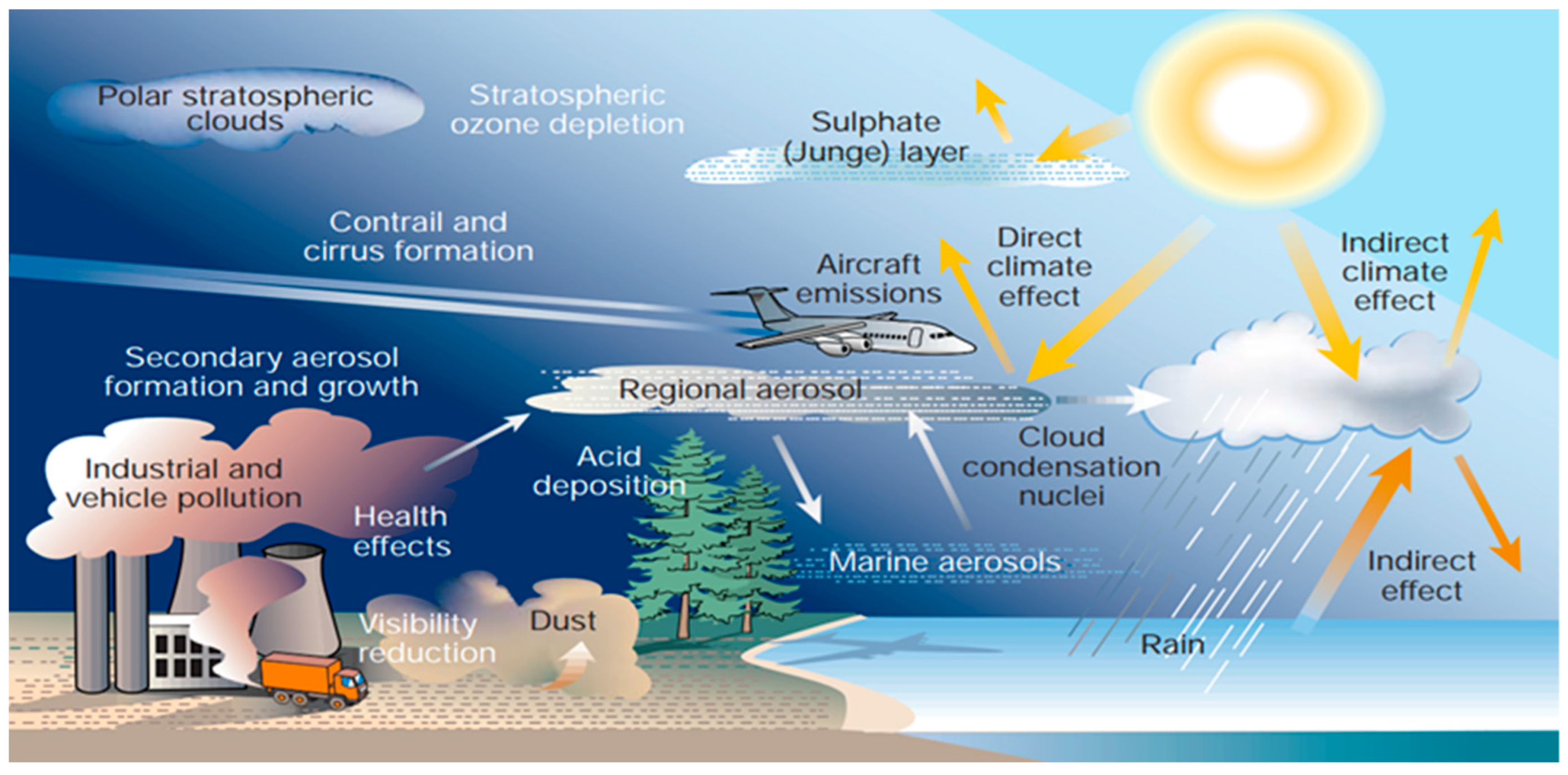

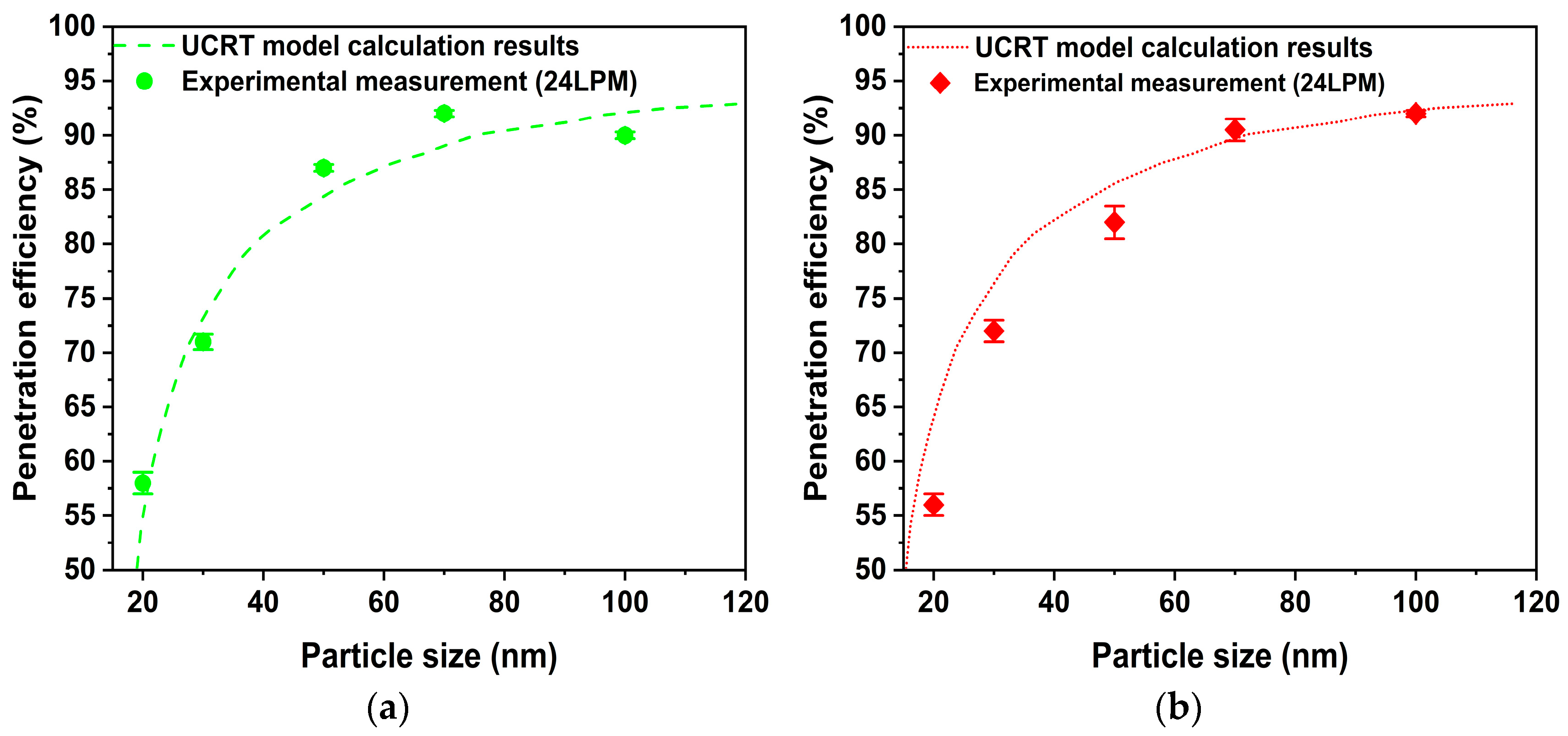
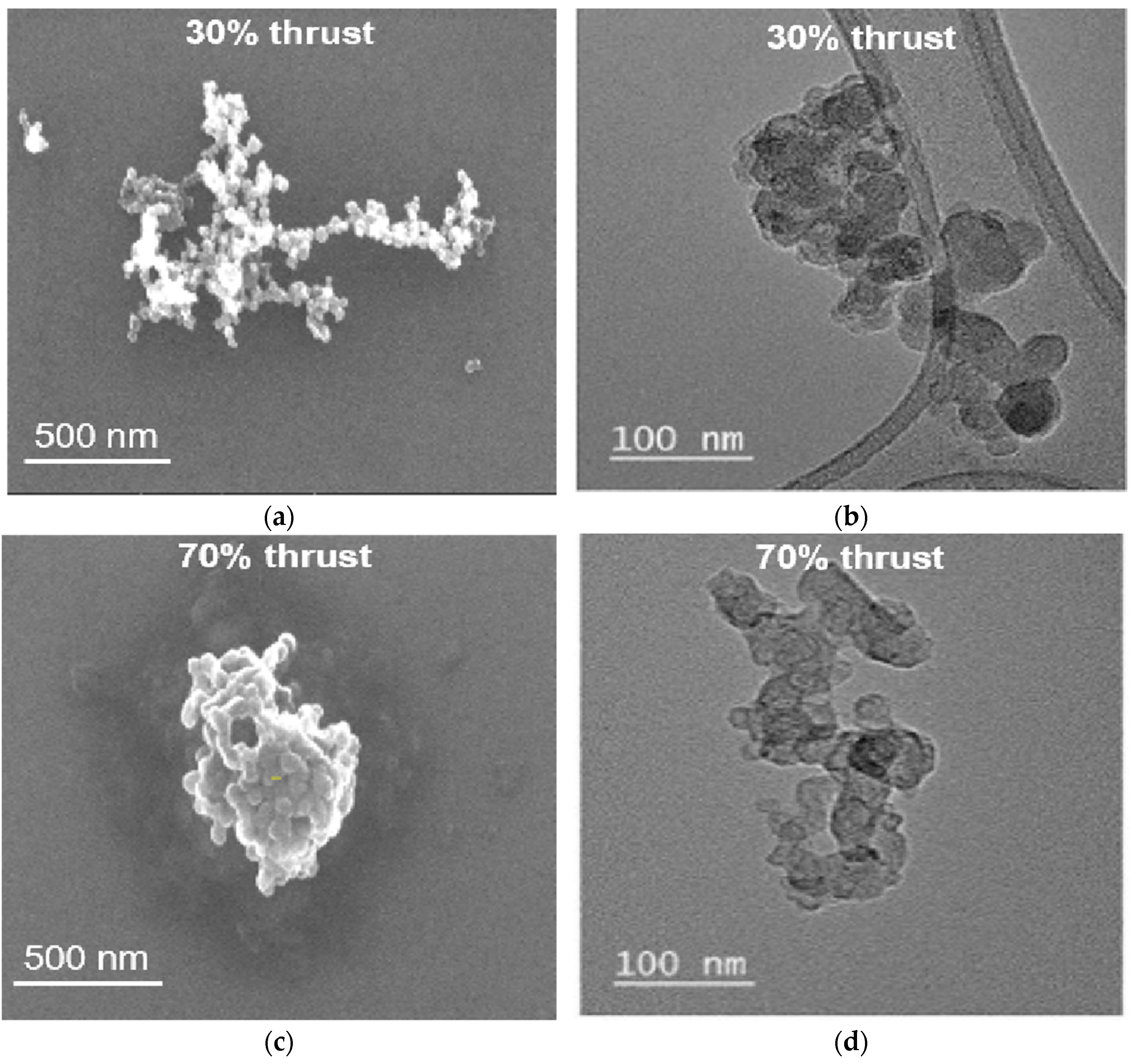
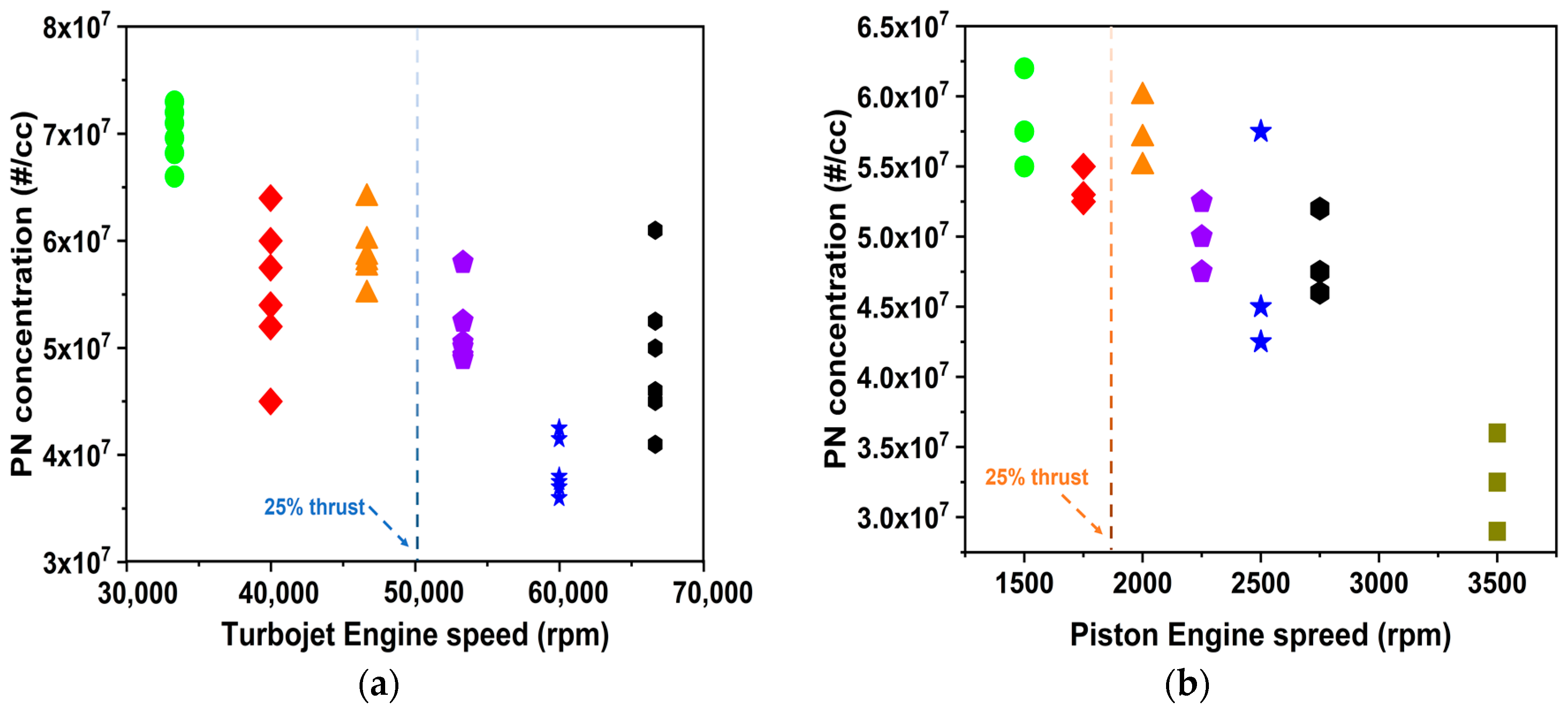
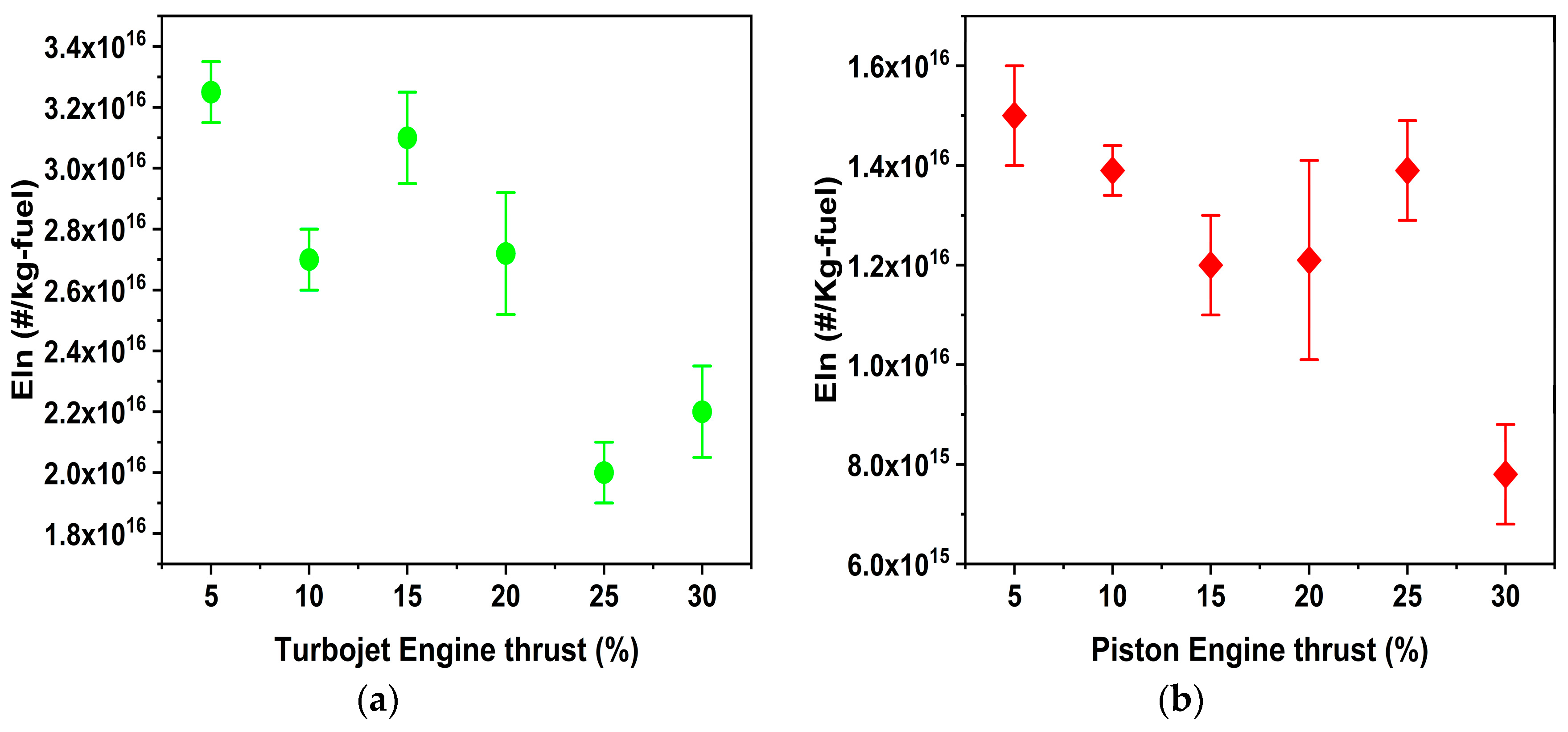
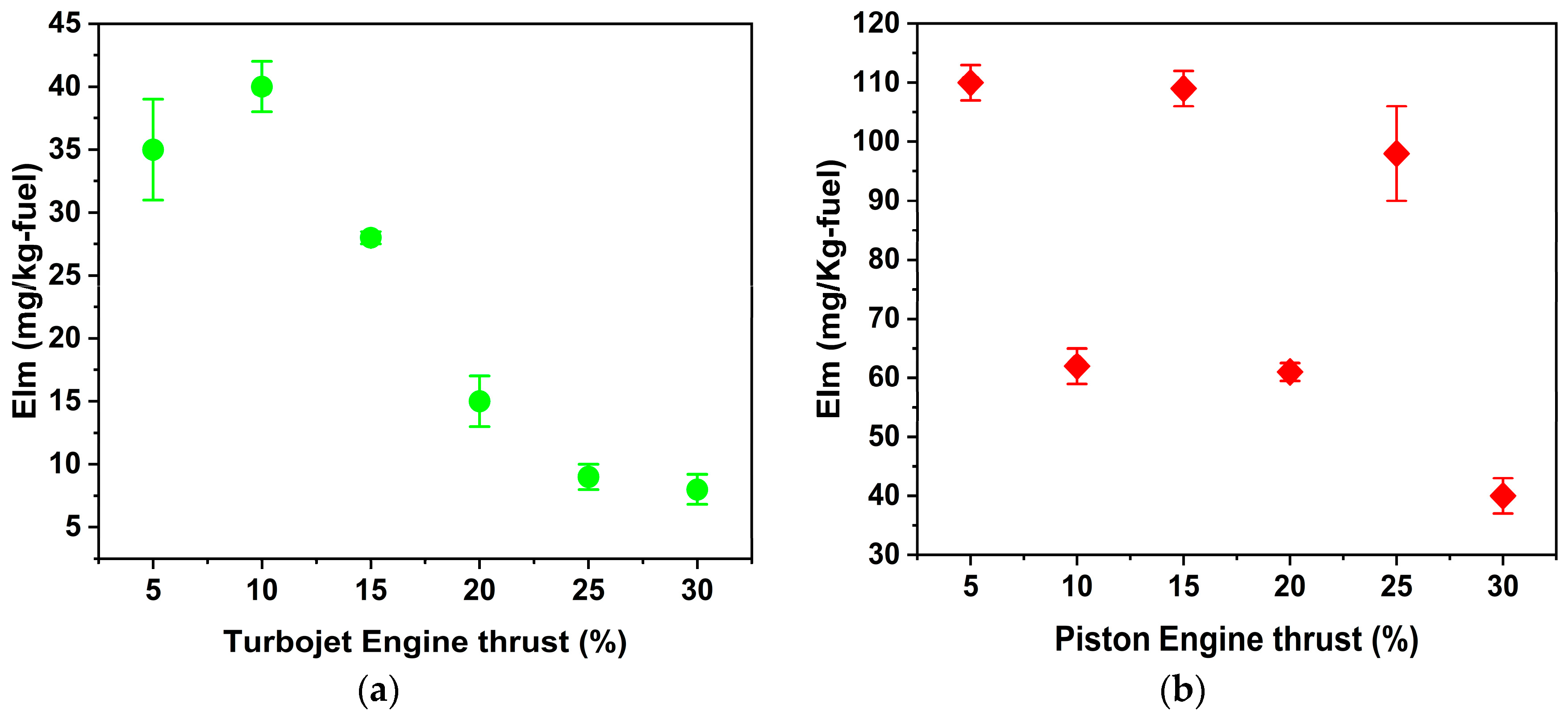
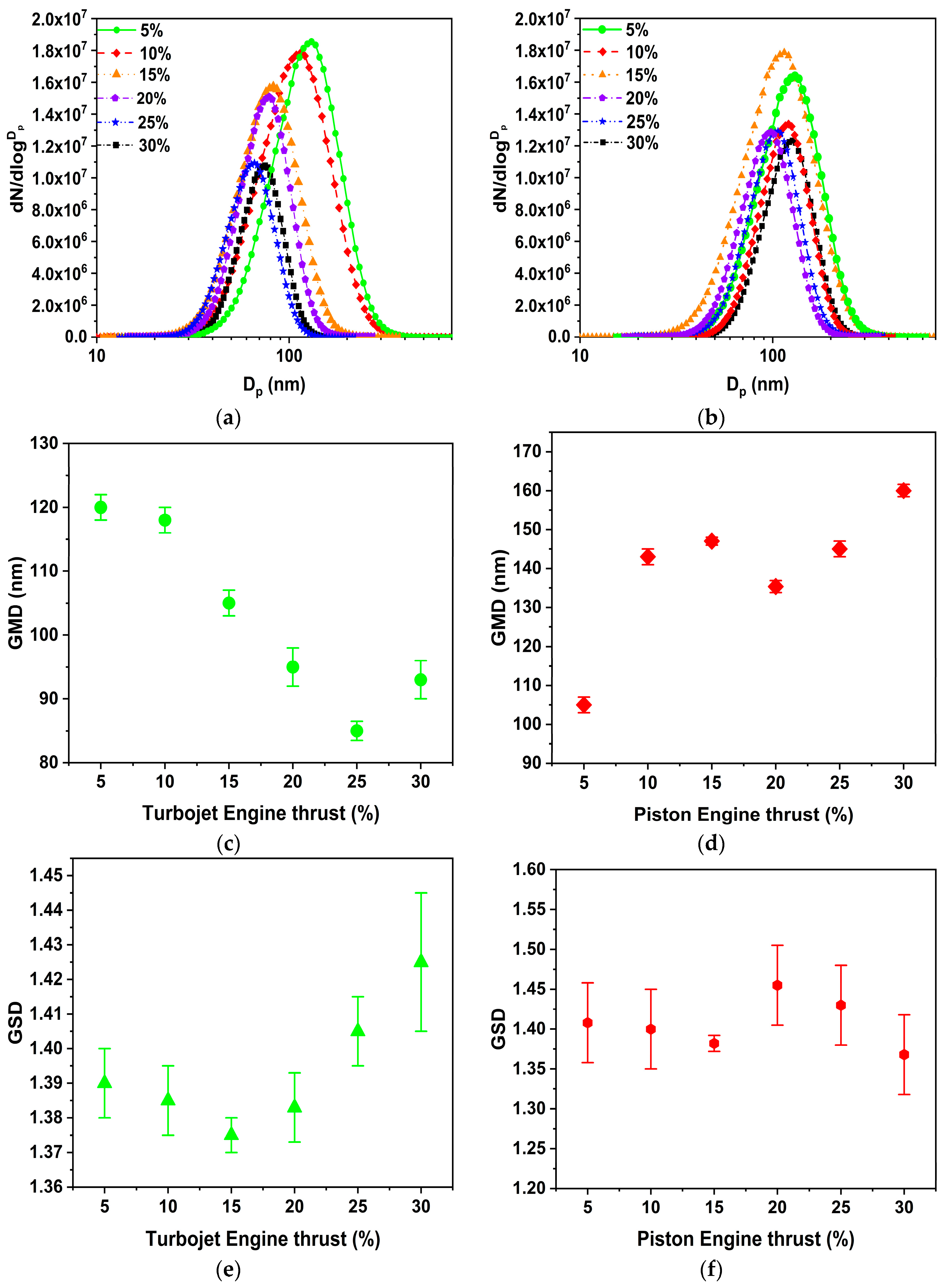
| Parameter | Units | Value |
|---|---|---|
| Idling speed | rpm | 35,000 |
| Idling thrust | N | 14 |
| Supercharge ratio | - | 3.55 |
| Idling fuel consumption | mL/min | 179 |
| Exhaust gas temperature | °C | 480–750 |
| Maximum speed | rpm | 106,000 |
| Maximum thrust | N | 300 |
| Equivalent horsepower | kW | 90 |
| Maximum speed fuel consumption | mL/min | 980 |
| Exhaust velocity | km/h | 2160 |
Disclaimer/Publisher’s Note: The statements, opinions and data contained in all publications are solely those of the individual author(s) and contributor(s) and not of MDPI and/or the editor(s). MDPI and/or the editor(s) disclaim responsibility for any injury to people or property resulting from any ideas, methods, instructions or products referred to in the content. |
© 2024 by the authors. Licensee MDPI, Basel, Switzerland. This article is an open access article distributed under the terms and conditions of the Creative Commons Attribution (CC BY) license (https://creativecommons.org/licenses/by/4.0/).
Share and Cite
Xu, Z.; Wang, M.; Li, G.; Hu, X.; Yang, P.; Zhu, M.; Zhang, B.; Chang, L.; Chen, L. Experimental Investigation of Particulate Number Measurement Methodology for Micro-Turbojet Engine Emissions. Aerospace 2024, 11, 548. https://doi.org/10.3390/aerospace11070548
Xu Z, Wang M, Li G, Hu X, Yang P, Zhu M, Zhang B, Chang L, Chen L. Experimental Investigation of Particulate Number Measurement Methodology for Micro-Turbojet Engine Emissions. Aerospace. 2024; 11(7):548. https://doi.org/10.3390/aerospace11070548
Chicago/Turabian StyleXu, Zheng, Minghua Wang, Guangze Li, Xuehuan Hu, Pengfei Yang, Meiyin Zhu, Bin Zhang, Liuyong Chang, and Longfei Chen. 2024. "Experimental Investigation of Particulate Number Measurement Methodology for Micro-Turbojet Engine Emissions" Aerospace 11, no. 7: 548. https://doi.org/10.3390/aerospace11070548
APA StyleXu, Z., Wang, M., Li, G., Hu, X., Yang, P., Zhu, M., Zhang, B., Chang, L., & Chen, L. (2024). Experimental Investigation of Particulate Number Measurement Methodology for Micro-Turbojet Engine Emissions. Aerospace, 11(7), 548. https://doi.org/10.3390/aerospace11070548











